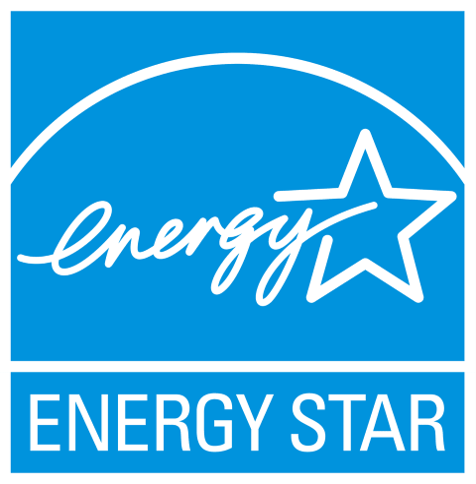Energy Star certified windows have revolutionized the way energy efficiency is approached in residential spaces, becoming a cornerstone for homeowners aiming to reduce their energy consumption. These windows are designed with cutting-edge technologies including improved frame materials, argon gas insulation, and special glass coatings, ensuring they meet the highest energy standards.

The incorporation of multiple panes of glass and warm-edge spacers further enhances their efficiency, significantly cutting down on heating and cooling costs. With Energy Star windows, homeowners can enjoy the dual benefits of environmental protection, facilitated by reduced energy usage, and substantial savings on household energy bills, with annual savings ranging between 7-15%.
What Is Energy Star?
Understanding the significance of Energy Star certification, especially in the context of solar heat gain coefficient and its impact on a home’s energy efficiency, is crucial. This certification, endorsed by the Environmental Protection Agency, sets rigorous criteria based on climate zones, ensuring that only products with superior energy performance make the cut. The growing market share of Energy Star qualified windows since 1998 attests to their effectiveness in fostering energy savings, comfort, and the protection of interiors from UV light exposure. Furthermore, the availability of federal tax credits for the purchase of high-performing Energy Star windows underscores the government’s commitment to promoting energy-efficient solutions.

Since its inception in 1998, ENERGY STAR qualified windows have seen a remarkable rise in market share, with nearly 270 million windows replaced across the United States, encompassing around 13% of homes nationwide. This transition has delivered substantial energy savings, totaling 26 billion kilowatt hours, resulting in a cost reduction of $5.2 billion. Insights gathered between 2004 and 2008 shed light on the effectiveness of ENERGY STAR in driving the adoption of qualified windows. Notably, in 2008, three out of every five homeowners chose ENERGY STAR qualified windows for their remodeling projects.
Additionally, a 2007 study conducted by the U.S. Environmental Protection Agency found that 74% of American households trust the ENERGY STAR label. Among those who purchased ENERGY STAR qualified products, 72% indicated that the label significantly influenced their purchasing decisions. These statistics underscore the growing recognition and impact of ENERGY STAR in promoting energy-efficient solutions among consumers, highlighting a shift towards prioritizing energy performance in home improvement projects among homeowners.
In 2022, the ENERGY STAR program saw significant updates and expansions. The EPA recognized organizations for their energy-efficient practices, and over 40,000 buildings have earned ENERGY STAR certification to date. New initiatives include the launch of the ENERGY STAR Home Upgrade program and the introduction of the 1 – 100 ENERGY STAR score for homes. Updates to product requirements and a focus on industries like chlor alkali demonstrate a continued commitment to promoting energy efficiency and sustainability.
Energy Star Windows: How They Work
Energy Star certified windows function through a combination of advanced technologies and strict performance criteria, designed to maximize energy efficiency and minimize environmental impact.

Here’s how they work, broken down into key components:
-
Advanced Technologies:
-
Multiple Glass Panes: Utilize two or more layers of glass to create an insulating barrier that reduces energy loss.
-
Low-E Coatings: Microscopic metallic particles reflect infrared and UV rays, keeping heat inside during winter and outside during summer, also protecting interiors from sun damage.
-
Gas Fills: Spaces between glass panes are filled with inert gasses like argon, enhancing insulation by reducing heat transfer.
-
Warm Edge Spacers and Improved Framing Materials: These components reduce heat transfer around the glass edges, contributing to overall thermal performance.
-
-
Performance Criteria:
-
U-Factor and Solar Heat Gain Coefficient (SHGC) Requirements: Energy Star windows must meet specific U-Factor and SHGC ratings that vary based on the climate zone, ensuring optimal performance in different environmental conditions.
-
Certification by the Environmental Protection Agency (EPA): Windows must be independently tested, certified, and verified by the National Fenestration Rating Council (NFRC) to meet stringent energy efficiency guidelines set by the EPA.
-
By meeting these rigorous standards, Energy Star windows provide significant energy savings, enhance comfort, protect against sun damage, and reduce the carbon footprint of a home.
Benefits of Energy Star Windows for Homeowners
Energy Star certified windows offer a plethora of benefits for homeowners, making them an essential component for energy-efficient living.

Here are some of the key advantages:
-
Cost and Energy Savings: Homeowners can achieve an average of 13% savings on heating and cooling costs nationwide by installing Energy Star certified windows, doors, and skylights. This reduction in energy bills is coupled with a significant decrease in carbon footprints, promoting both environmental and financial well-being.
-
Comfort and Protection: These windows enhance comfort by maintaining warmer interior glass surfaces during winter and minimizing heat gain during summer, without compromising on the entry of visible light. Additionally, they are equipped with coatings that protect home valuables from harmful UV light, reducing fading by up to 75% and ensuring the longevity of interior furnishings.
-
Federal Tax Credits and Increased Home Value: The federal government offers a tax credit of 30% of the cost, up to $600 for residential windows, for products meeting the Energy Star Most Efficient criteria. Beyond monetary savings, upgrading to Energy Star certified windows can increase home value, with an average return on investment of 72.3% for replacing old windows. This is not only a financial advantage but also enhances the property’s curb appeal.
Energy Star windows are not only beneficial for residential properties but also for high-rise buildings seeking energy efficiency. The certification process for Energy Star in high-rise buildings involves an assessment of the entire structure, ensuring comprehensive energy savings. This highlights a key aspect of Energy Star, extending its reach beyond individual products to encompass the holistic energy performance of buildings.
Moreover, Energy Star’s multifamily high-rise program offers a structured approach for assessing and certifying buildings based on their energy efficiency. By participating in this program, high-rise buildings can earn Energy Star certification, signifying their commitment to sustainability and reduced environmental impact.
In addition to individual unit eligibility, Energy Star’s multifamily high-rise program considers factors such as building design, construction materials, and energy usage patterns. This comprehensive evaluation ensures that certified buildings not only meet energy efficiency standards but also contribute significantly to overall energy savings and environmental stewardship.
Overall, Energy Star’s multifamily high-rise program underscores the organization’s commitment to promoting energy efficiency across various building types, fostering a more sustainable built environment for communities and homeowners alike.
Understanding Energy Star Certification
Understanding Energy Star Certification for windows and doors involves a comprehensive process that ensures products meet specific energy efficiency criteria tailored to different climate zones. This certification process is overseen by the National Fenestration Rating Council (NFRC) and encompasses various performance metrics:
-
Performance Criteria:
-
Windows: The criteria are based on U-Factor and Solar Heat Gain Coefficient (SHGC) ratings, which vary according to the climate zone to ensure optimal energy efficiency.
-
Doors: The focus is on the amount of glass (glazing level) they contain, with performance standards also verified by the NFRC.
-
For a product to be Energy Star certified, it must:
-
Comply with the ENERGY STAR Eligibility Criteria, defining performance requirements and testing procedures.
-
Obtain Certification from the NFRC, ensuring the product has been independently tested and meets the strict guidelines for energy efficiency.
-
Adhere to ENERGY STAR Identity Guidelines, which includes proper use of the ENERGY STAR name and marks on qualified products and clear, consistent labeling.
Additionally, manufacturers and partners are encouraged to participate in third-party verification testing, cooperate with market assessment research, and actively promote the availability of ENERGY STAR qualified products. This holistic approach not only certifies the energy efficiency of windows and doors but also fosters a commitment to environmental sustainability among manufacturers and consumers alike.
Are Vistaza Windows Energy Star Certified?

Vistaza Windows, a prominent name in the realm of high-performance uPVC Windows in the United States, has carved a niche for itself, especially in mid-rise projects. Their offerings are not just about aesthetics but are deeply rooted in ensuring structural integrity, energy efficiency, and superior sound control. These windows are designed to maintain thermal comfort by minimizing heat transfer, which significantly reduces the heating and cooling demands of any space. With a U-Factor as low as 0.15, Vistaza Windows stand out for their energy efficiency, making them an attractive choice for those looking to enhance their home’s energy performance.
Vistaza caters to both commercial and residential customers, offering a wide range of Exterior Doors and Windows. Notably, their product lineup includes Passive House certified windows. These windows are not only energy efficient but also meet the stringent requirements of PHI and PHIUS, ensuring they contribute to a home’s overall energy efficiency and environmental sustainability. Contact Vistaza to learn more about energy star certified windows.




